
Cherry Salmon • The Second Stage --Vol.63--
Fresh Run
Cherry salmon were really in the Kuzuryu River on February 1st. Although the frozen snow remained on the mountain and it was too cold to fish cherry salmon, they had already come upstream and stayed still in the pool. Those cherry salmon we two caught on February 1st and 2nd were not fresh ones, as I had expected. Judging from their colours and scales, they seemed to have come upstream in the end of the last December.On the opening day there are a few fish that have come upstream for the last several months. If those fish are caught, their pools will be empty. That means anglers have no chance of catch for a while because new fish do not come into there so soon. That is why I try to fish the pool where there has been no catch yet.

Snow melting water flows into the river, which is the sign of beginning of the high season for cherry salmon fishing.
We two had fished around most of main pools for the first 2 opening days. Even considering that a half of those pools had been in bad condition, I got the feeling that only a few fish remained at the upper reaches of National Route 8.
The Time of Melting Snow
Immediately our catch of cherry salmon on the opening days became known to the fishing companions. Some of them dashed to come but in vain. No more cherry salmon was caught in February.Nearly in the end of February spring came in the Kuzuryu River. Snow melting water was flowing all the time and the river looked beautiful, filled with much water. When a large amount of snow melting water flows into the sea, cherry salmon staying on the coast get excited and start coming upstream. The high season for cherry salmon fishing is coming soon!

As cherry salmon stay longer in the river, they look more like river fish.
In those days only a small number of anglers were keen on cherry salmon but the number had almost doubled in a year. Unfortunately cherry salmon fishing is so difficult that very limited anglers had succeeded in catching them. I proposed that we should go fishing together in the Kuzuryu River.
On March 6th 1989, more than 10 eager anglers gathered from east and west of the Kuzuryu River. Later they were all known as experts of cherry salmon fishing. As other cherry salmon fishermen were seldom there, it looked as if we had hired the whole river to enjoy a fishing tournament.
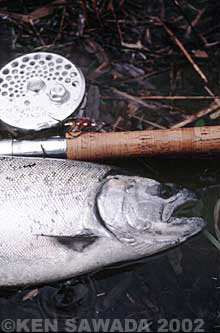
Cherry salmon that came upstream during midwinter have rusty winter-colour, like yamame trout that survive the winter.
On that morning I crossed Gomatsu Bridge and stood on the embankment below the power transmission lines to watch the river. The water amount was larger by 50% than the opening day. Nearly 2 weeks had passed since pale blue snow-melting water started flowing into the river. Surely new fish have come upstream now!
Do they choose different staying places from the fish that have come upstream long before? Then I smiled to myself, thinking how I had an easy-going expectation, typical of fishermen. I know that staying fish would never come here. But I wish the fish to come upstream quickly and to stay here once they arrive. What a selfish idea!
There was no catch here for more than a month probably because only a few fish were staying here. It would be better to aim at new fish, coming upstream now in high water.
Staying fish are nervous about the pool shape or size, whereas moving fish, swimming up at high speed, just stop to take some rest. The latter fish coming upstream in high water full of snow melting water want to rest when they become tired. The fall or the barrier of the artificial dam is the most difficult place for them to get over but there is none downstream. The second most difficult place is long fast current. The longest one around here spreads above the bridge over Hokuriku Road. It spreads as far as 200 or 300m. The fish get exhausted by swimming up the fast current. Then the pool is waiting for them. In addition, there are 2 heads of the pool. The fish have to choose which one to go ahead. They must stay longer here. It is like a small teahouse on the mountain pass. It is a perfect fishing spot.
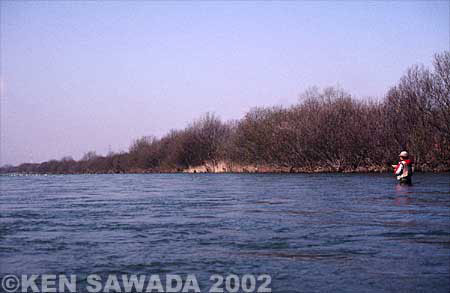
The end of Hatayaura pool is filled with snow melting water. We can see the head of the pool of the front of kindergarten in the distance. The place shows the great power of the nature.
I looked around the embankment downstream again. I could faintly see the junction pool far away beyond power transmission lines. That spot is the most suitable! The temperature of air and water is the highest at noon. I decided my fishing time there and went downstream now.
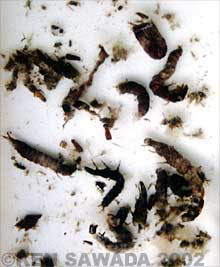
Those worms are what staying cherry salmon have eaten. They do not look eager to get big bait.
I thought I would be able to fish another 2 or 3 points before noon. Several anglers had been fishing in the pool of the front of kindergarten and Hatayaura when I crossed Gomatsu Bridge in the morning. Probably they kept fishing there during the whole morning. I had to find other pools with no angler.
There was an angler in the pool above National Route 8, too. Anglers tend to gather to the spot where the fish have been caught before. As more than a month had passed since the previous catch, it was quite natural to think that new fish had come into there. I would have chosen this pool, too, if possible.
There was no angler in the pool down National Route 8. I parked on the embankment and walked down to the river through withered pampas grass. Here the river was wider and shallower than the last April. I cast the line carefully in the slow-flowing spots and came back to the car. This pool seemed to change into a good point in the hot season of high water-temperature but now the flow was too shallow and rapid.
Then I drove to the back of the school. We have to walk a long distance from the embankment to the pool, which keeps most anglers away. I cast the line for 40minutes without any response. It was already past 11a.m. I hurried upstream.
The Junction Pool
I parked under the transmission lines and walked on the bank across the embankment. Fine whether without a cloud lasted from the morning, unusual in March. The strong wind was blowing under the clear sky but I did not feel cold because of warm weather and long walk.Eager anglers in the morning probably were taking lunch now. Only one angler was fishing the pool below the transmission lines. With his consent, I headed farther downstream.
The junction pool was full of water. The end of the pool had many waves now, while the surface looked like a mirror in early summer. The waves were so turbulent that the border between the pool and the long fast current downstream was not clear.
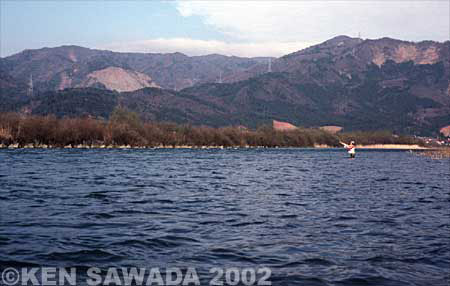
The pool of the front of kindergarten spread like a lake. This water encourages cherry salmon to come upstream from the sea.
Two fast current joined here and flowed more powerfully against the opposite bank. Then it bore the bottom to form a deep pool. Turbulent water showed a steep slant of the river bed. If I cast the line at the edge of the opposite bank, the fly would never sink into the stream. But if I cast the line in the gentle flow in front, I will be able to make a good performance of the vertical turn of the line.
Then I stood beside the head of the pool and cast the line to the opposite bank in front. Pink−blue Aquamarine was tied on 35mm Waddington Shank put to the end of type II sinking line, just as the opening day. Water was rather transparent in spite of a large amount of snow melting water. The water temperature was 7 degs C., higher by 1 degs C. than in the morning. I did not need to use the more rapidly sinking line, judging from the successful performance of type II on the opening day. Although the wind was blowing stronger, 17ft rod helped me very much with both casting and line performance. Both activities were much easier than the last year.
I fished down 2m at every casting. At the 5th casting I drew near to a small pussy willow in the water that was usually on the bank. Now the water level was 60cm higher than medium water.
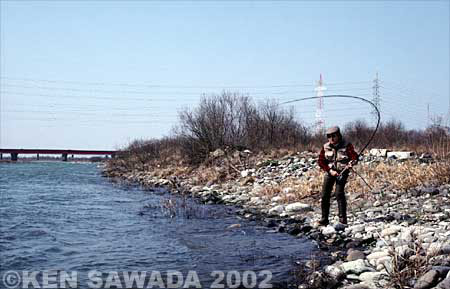
A cherry salmon coming in snow melting water made 17ft rod bent in a large arc
and did not move from the heart of the stream.
and did not move from the heart of the stream.
Taking a detour to avoid the tree, I cast the fly a little upstream. The fly disappeared as soon as the line settled on the edge of the opposite bank and sank into the water. I tightened the line at good timing. The fly line made the vertical turn in the pool. The line stuck into the water did not move, as if the river did not flow at all.
Making sure of the nice vertical turn, I retrieved the line. Immediately I felt a heavy shock of pull. I raised the rod carefully but the line never moved as if it had snagged at the bottom.
The rod bent in a large arc did not move, either. I felt a vivid pull from the living creature in my hands. The fish seemed to be different from what I had ever fought with. I walked slowly to the bank, thrilled with excitement.
-- To be continued --
- NET SHOP INFORMATION
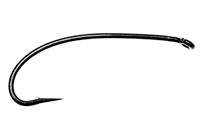
SL6 Black Spey Hooks
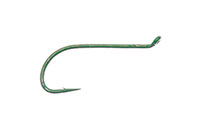
DU3 Limerick Spinner Hooks
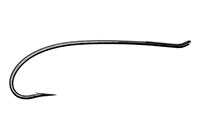
SL4 Single Bartleet Hooks
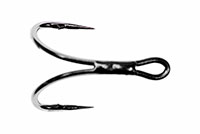
XD1 Tube Fly Double Hooks
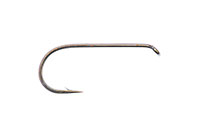
DD2 Flat Perfect Hooks
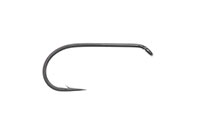
DD1 Black Terrestrial Hooks
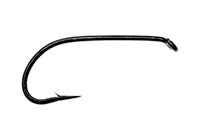
TD4 Old Limerick Wet Hooks
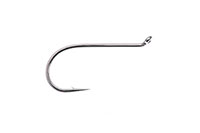
DU1 Silver May Hooks
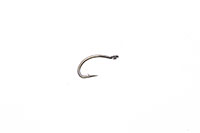
MU1 Flat Midge Hooks
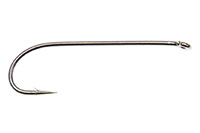
LD3 Long Limerick Hooks
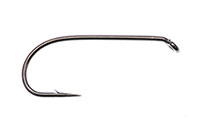
TD2 Summer Sproat Hooks
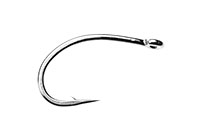
XS1 Tube Single Silver Hooks
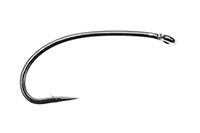
TD6 Siver Sedge Hooks

SL5 Black Spey Hooks

DU3 Limerick Spinner Hooks
- TROPHY CLUB
- FLY SHOW
- EXHIBITION
- MASTERS`
- FLY DRESSING CONTEST Archives
- TRAVELLER Archives
- TACKLE IMPRESSIONS Archives
- ANGLERS` PHOTO GALLERY Archives
- ----------------------------------------------
- トロフィークラブ
- フライショー
- エキシビション
- マスターズ
- フライドレッシング・コンテスト・アーカイヴ
- トラヴェラー・アーカイヴ
- タックル・インプレッション・アーカイヴ
- アングラーズ・フォトギャラリー・アーカイヴ
株式会社サワダ 185-0021 東京都国分寺市南町3-13-4
SAWADA'S INC. 3-13-4 Minamicho, Kokubunji, Tokyo 185-0021, Japan
写真・ドキュメントの無断転載を禁じます。
All the images and documents found on this site are owned by Ken Sawada and may not be used without permission.
But, link to this site is FREE.
Copyright © 2000 - 2025 SAWADA'S INC.. All rights reserved.
SAWADA'S INC. 3-13-4 Minamicho, Kokubunji, Tokyo 185-0021, Japan
写真・ドキュメントの無断転載を禁じます。
All the images and documents found on this site are owned by Ken Sawada and may not be used without permission.
But, link to this site is FREE.
Copyright © 2000 - 2025 SAWADA'S INC.. All rights reserved.
